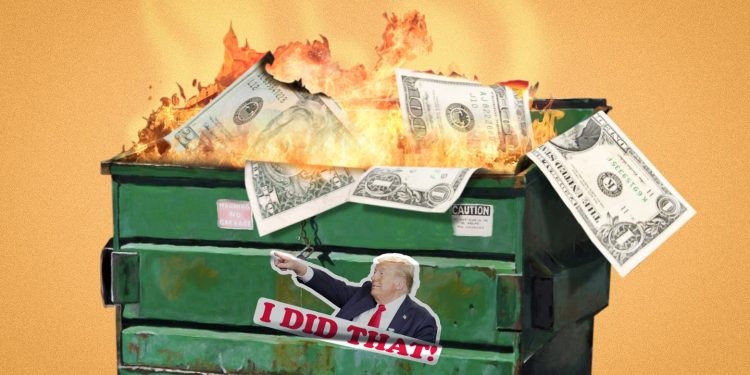Register for The Slatest to obtain the most insightful analysis, criticism and advice, delivered daily in your reception box.
For decades, American consumers, global investors and international traders could interact in a productive way in a shared economic order thanks to their mutual trust in a powerful instrument: the US dollar. In the aftermath of the great depression, when the nations judiciously ceased to support its currencies with gold and the United States has cemented its position as an economic guardian of the globe, the dollar has become the global reserve currency, a robust place for the storage of value, for trade, for the circulation of money. Everyone could buy American debts through long -term and short -term bonds issued by the Treasury Department, with reasonable insurance that these investments were safe and guaranteed. In turn, the States benefited from this hegemony, which gave it economic power over other nations. Despite diplomatic conflicts, despite the whisk interest rates, despite the economic crises born in the United States which has embraced the whole world, the stability of the dollar has remained the main trade engine, the determinant of the new world order. And, for the most part, it was good (for us).
Now, thanks to President Donald Trump, the reliability of the dollar and the advanced position of the world are no longer sacrosanct. And the consequences of this possible change are astounding – potentially catastrophic.
When the stock market started to dive last week in response to the prices of the attractive “liberation day” of Trump, the economist Adam Tooze warned that the right cards to follow were not these commercial clues, but the bond markets. Throughout the month, you can identify a dark indicator: pricing ads generally increase the value of the dollar, because higher import taxes (at the price in dollars) tend to weaken the valuations of the currency of other countries and the power of expenditure. But this time, it was the dollar who weakened in the aftermath of the Liberation Day. Normally, traders would try to preserve their money by selling their shares at a good price – hence the market crash – then put these more safe and longer term investment income, such as treasury obligations (that is to say the US dollars). This time, however, traders were also sale Off their treasure properties, a sign that they were nervous about the American economy. Bonds of bonds at 10 years have reached their highest level for years, which tends to occur only in moments of economic crisis. At a time of already high interest rate, high yields make so many parts of the daily economy – bank loans, mortgages, personal credit, insurance – so much more prohibitive than they had already been.
Seeing behind the negotiation offices, the Financial Times noted that international hedge funds and asset managers have sold their treasury assets in order to reduce their exposure to risk – and, in some cases, swiveling in place of physical cash funds. And, despite generalized speculation, countries like Japan have not I have poured their treasure assets in mass – which is relief, because it is one of the greatest foreign holders of US dollars. If this had been the case, panic would have been justified.
However, concerns remain. The overall sale in the treasurers of 10 and 30 years continued until then this week, persisting in its worst rout from the pandemic crash. (Although, to be very clear, it is not as bad as this moment.) The yield of the treasure at 30 years has reached levels that he had not seen since the stock market crash of the late 1980s; The yield in 10 years is at invisible levels since the great recession. In addition, Japan has I have reduced some of its treasure participations throughout the year, although gradually – not with the type of sudden night tinkering that we saw this week. And China (the largest holder of foreign treasurers) recently ordered public level banks to cling to the purchase of more dollars, according to Reuters. With the continuous increase we saw this Friday morning, there is no reason to believe that the basic traders get rid of their treasures.
On a larger scale, there are investors who are the cutting edge of assets and securities linked to the United States. The dollar no longer commands the overwhelming share of the world reserves which it made only two decades ago; The passage from the hiding places from the public treasury to more privatized assets (such as the hedge funds) opens up the whole of the company to greater volatility on the market. Foreign currencies have been better placed than American Treasurys and can become more attractive investment options because European, Chinese, Japanese and Australian currencies gain bullish forecasts. Deutsche Bank warned in an investment note on Wednesday that various financial entities and banks are deployed from US dollars, opening a path to “unexplored territory”.
There have been indices in the world dollar in decline for a few years now. As I noted at the end of last year, the economic shock of the Covid recession led various nations to fill up on gold reserves in their central banks such as coverage against the dollar. This international gold rush persisted in the aftermath of the re -election of Donald Trump, as a business partners (very reasonably, it turns out!) not The US dollar. Given the diplomatic chaos of Trump’s last term and the rhetoric of the campaign campaign which showed that he clearly understood nothing about the prices, there was no reason why anywhere, anywhere, to believe that the United States would remain a stable area for a long-term investment.
And it was not only prices that the world had to worry about – it was a bit of everything. Economic relations with the United States is now increasingly unstable, unreliable and unattractive, because Trump’s diplomatic and financial policy leaves everyone uncertain about their position. This does not help Trump prematurely cancel all this international aid, completely knowing any trust remaining in the basic American contracts.
In February, asset directors told the Bank of America that they preferred to turn to international companies and golden bars instead of American actions. Actions at the continent have made European actions, and generalized hostility towards the United States has inspired Goldman Sachs to compile an in-depth report on the way the boycotts of American brands spread far beyond just Canada. A popular Dutch researcher has even told European business owners to stop storing their virtual data in American cloud servers.
What is even more terrifying is that the actions of the Trump administration appear at the Deutsche Bank and other analysts such as deliberate tank of the dollar. The attacks on the independence of the federal reserve and the threats of replacing Jerome Powell are sufficiently frightening – the prospect of the mad king is unleashed by the central bank. But in a report of last month, Bloomberg noted an exasperating contradiction in the declarations of Trump’s campaign: “Trump said that he wanted to maintain the central role of the dollar on a global scale, threatening to retaliate against any country which tries to decline his trade in the American currency.
And then there is the infamous “Mar-A-Lago Agreement”. Stephen Miran, a user -friendly asset manager for the crypto who now heads the Trump’s economic adviser council, wrote a document last November which pleaded to deliberately weaken the dollar and use the threat of prices so that other countries spend more for factories and American results, at a lower cost, long -term. (He recently doubled on this subject.)
It won’t work. The other nations with arms to devalue the dollar completely Destabilize the global economic order, throwing the entire system into chaos until international diplomacy is satisfied with a new reserve of trusted reserve. In addition, intimidation would not be effective. China has already dealt with the belligerent trade policy of Biden’s mandate and Trump’s first round, and the East Asia giant is now much better equipped to resist an aggressive trade war with the United States than anyone in the Trump administration does not realize it.
Really, there are no more “adults in the room” now. The members of the cabinet claim that everything is fine; The House of Representatives has just made a massive and poorly won tax reduction; The henchmen of the 2025 project who guided this administration have already written that they wanted to return to the ruinous gold stallion.
According to various reports of initiates, it was the efforts of the “Yippy” obligations market that led Trump to back up on his higher reciprocal rates, even though he raised tasks against China and maintained other universal rates in place. However, cash holders are clearly not assumed, and they have been old for years at this stage. If the US dollar loses its power, this country would face an unprecedented financial crisis. If you thought recent inflation was bad, wait until you have to face a system where no one even wants touch The dollar because there is no more world faith, plunging it into the barge. No gold reserve or government cryptocurrency reserves would save us.
We are not there yet. I hope we will never get there. But I will leave the last word to Adam Tooze: “For life to continue to continue something like normally, this story must remain, to some extent, a fear rather than a reality.”



